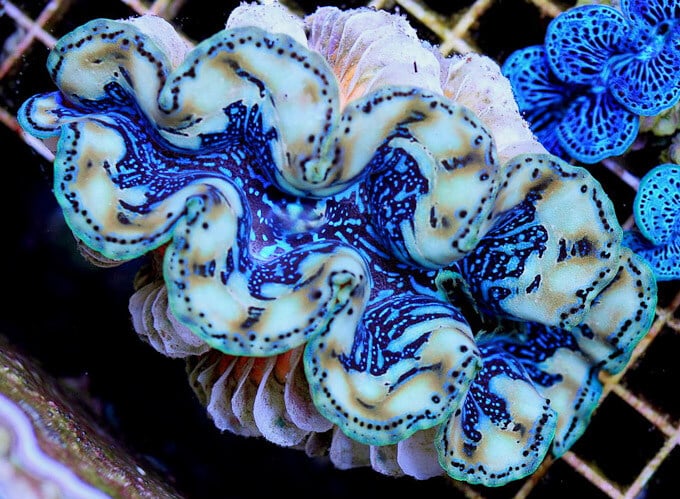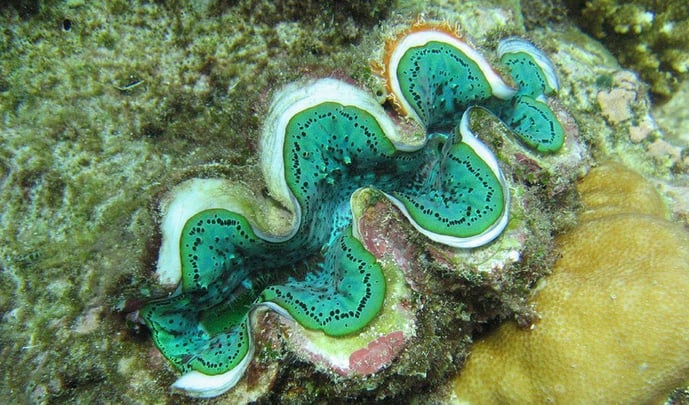Understanding giant clams: Ecological significance

Jordan
4
min. read

Abstract
Giant clams play multifaceted roles within coral reef ecosystems, serving as providers of food and shelter, contributors to reef productivity, and architects of reef structures. Their symbiotic relationship with algae, which reside within their tissues, enables them to derive a substantial portion of their energy through photosynthesis. Furthermore, their filter-feeding contributes to nutrient cycling within reef environments, underscoring their ecological significance.
1. Symbiosis
The main ecological significance for giant clams lies in their symbiotic relationship with photosynthetic algae, commonly known as zooxanthellae. These microscopic algae reside within the tissues of giant clams, where they harness the power of sunlight to produce energy through photosynthesis. In return, the clams provide a safe haven and a steady supply of nutrients for their algal partners. This symbiotic association not only fuels the growth and metabolism of giant clams but also generates surplus energy that benefits the entire reef ecosystem. Through photosynthesis, giant clams contribute to the primary productivity of coral reefs, producing organic matter that serves as a vital food source for a myriad of reef inhabitants. This influx of energy cascades through the food web, sustaining diverse communities of fish, invertebrates, and other marine organisms. Moreover, the nutrient-rich waste products excreted by giant clams further enrich the surrounding environment, fueling the growth of algae and other primary producers.
The main ecological significance for giant clams lies in their symbiotic relationship with photosynthetic algae, commonly known as zooxanthellae. These microscopic algae reside within the tissues of giant clams, where they harness the power of sunlight to produce energy through photosynthesis. In return, the clams provide a safe haven and a steady supply of nutrients for their algal partners. This symbiotic association not only fuels the growth and metabolism of giant clams but also generates surplus energy that benefits the entire reef ecosystem. Through photosynthesis, giant clams contribute to the primary productivity of coral reefs, producing organic matter that serves as a vital food source for a myriad of reef inhabitants. This influx of energy cascades through the food web, sustaining diverse communities of fish, invertebrates, and other marine organisms. Moreover, the nutrient-rich waste products excreted by giant clams further enrich the surrounding environment, fueling the growth of algae and other primary producers.

Image Credits - https://snorkelverse.com/glossary/giant-clam/
2. Reef Formation and Maintenance
Giant clams, beyond their role as primary producers through their symbiotic relationship with photosynthetic algae, play a crucial role as architects of coral reef structures. By anchoring themselves firmly to the substrate and secreting calcium carbonate (CaCO₃), they actively contribute to the formation and maintenance of the reef framework. This secretion process involves the deposition of calcium carbonate over their lifespan, which can span several decades. The accumulation of calcium carbonate not only adds to the structural complexity of the reef but also provides a robust foundation for the growth of other reef-building organisms such as corals.
The physical presence of giant clams on coral reefs creates a variety of microhabitats that support a diverse array of marine life. Their shells offer hard surfaces for the attachment of sessile organisms such as algae, sponges, and small corals. Additionally, the spaces around and within the clam's shell can serve as shelters for a multitude of organisms, including fish, crustaceans, and mollusks. This increased habitat complexity is critical for the survival and proliferation of many species, contributing to the overall biodiversity of the reef ecosystem.
3. Biodiversity Enhancement and Promoting Ecosystem Resilience
The habitats formed by giant clams support a high density of marine species, each occupying specific ecological niches. The presence of these clams encourages a higher species richness and abundance in reef areas. The diverse communities that develop around giant clams benefit from the shelter and resources provided by these bivalves, leading to intricate food webs and complex ecological interactions. This biodiversity is crucial for the health and resilience of coral reef ecosystems, as it enhances the system's ability to withstand and recover from disturbances such as storms, bleaching events, and anthropogenic impacts.
Additionally, through their contributions to reef architecture and biodiversity, giant clams play a pivotal role in promoting ecosystem resilience. Healthy and complex reef structures created by giant clams can buffer against physical impacts, such as wave action and sedimentation. Moreover, the biodiversity supported by these clams contributes to the stability and functionality of the reef ecosystem. Diverse ecosystems are generally more resilient to environmental changes because they can maintain ecological functions even when some species are stressed or lost.

Image Credits - https://reefbuilders.com/2014/10/07/giant-clams-specialized-harvest-light-thought/
4. Water quality
The filter-feeding behavior of giant clams plays a crucial role in maintaining water quality within reef environments. As they draw in water to extract plankton and suspended particles, they help to clarify the surrounding seawater, reducing turbidity and enhancing visibility. This filtration process not only benefits the clam itself but also improves conditions for other reef inhabitants, promoting overall ecosystem health. However, the ecological significance of giant clams extends beyond their direct interactions with other organisms. As ecosystem engineers, they influence nutrient cycling, sediment dynamics, and reef structure, shaping the ecological processes that govern coral reef ecosystems. Their presence alters the physical and chemical environment of reefs, creating microhabitats that support specialized communities of organisms.
The presence of giant clams also influences nutrient cycling within the reef ecosystem. Through their feeding activities and metabolic processes, they recycle nutrients such as nitrogen and phosphorus, which are essential for the growth of primary producers. This nutrient recycling supports the productivity of the reef and sustains the food web. Additionally, the symbiotic algae within the clams' tissues perform photosynthesis, producing oxygen and organic matter that benefit the surrounding marine life.
5. Summary
Giant clams are keystone species within coral reef ecosystems, playing pivotal roles that extend far beyond their imposing stature. From their symbiotic partnership with photosynthetic algae to their contributions to reef productivity and structure, these remarkable creatures embody the interconnectedness and complexity of marine ecosystems. Understanding their ecological significance is crucial for moving forward with programs that can help facilitate reef restoration activities and safeguard the health and resilience of coral reefs for generations to come.

Image Credits - https://www.australiangeographic.com.au/topics/science-environment/2017/09/the-oceans-giant-clams/
Sources:
Featured Image Credits - https://reefbuilders.com/2014/10/07/giant-clams-specialized-harvest-light-thought/
Neo, M. L., Eckman, W., Vicentuan, K., Teo, S. L. M., & Todd, P. A. (2015). The ecological significance of giant clams in coral reef ecosystems. Biological Conservation, 181, 111-123. https://doi.org/10.1016/j.biocon.2014.11.004
- This paper discusses the role of giant clams in coral reef ecosystems, highlighting their contributions to reef structure, nutrient cycling, and providing habitat for other marine organisms.
Klumpp, D. W., & Griffiths, C. L. (1994). Contributions of phototrophic and heterotrophic nutrition to the metabolic and growth requirements of four species of giant clams (Tridacnidae). Marine Ecology Progress Series, 115, 103-115. https://doi.org/10.3354/meps115103
- This study investigates the nutritional strategies of giant clams, emphasizing the importance of their symbiotic relationship with photosynthetic algae and their role in the nutrient dynamics of coral reefs.
Van Wynsberge, S., Andréfouët, S., Gaertner-Mazouni, N., & Wabnitz, C. C. (2016). Drivers of density for the exploited giant clam Tridacna maxima: A meta-analysis. Fish and Fisheries, 17(4), 982-1004. https://doi.org/10.1111/faf.12158
- This meta-analysis examines the factors influencing the population density of Tridacna maxima, providing insights into the ecological and anthropogenic pressures affecting giant clams and their conservation status.
Ricciardi, A., & Bourget, E. (1999). Global patterns of macroinvertebrate biomass in marine intertidal communities. Marine Ecology Progress Series, 185, 21-35. https://doi.org/10.3354/meps185021
- This paper includes a discussion on the biomass contributions of various macroinvertebrates, including giant clams, to marine intertidal communities, emphasizing their ecological importance.
Fisher, C. R., & Fitt, W. K. (1984). Photosynthesis and respiration in Tridacna gigas as a function of irradiance and size. Biological Bulletin, 167(3), 637-650. https://doi.org/10.2307/1541291
- This research explores the physiological responses of Tridacna gigas to varying light conditions, shedding light on the photosynthetic efficiency and metabolic requirements of giant clams and their role in the energy dynamics of reef ecosystems.